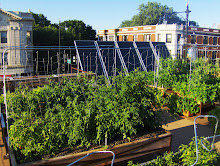
This past Saturday 30 volunteers showed up to help regenerate the soil for the new season of growing. They tilled and shoveled the soil (some of which was frozen!) and then added a thin top layer of compost, to bring new nutrients into the beds. Our compost is coming from Vermont Compost and is hearty to help supplement the minerals that were taken out by our crops last year.



We will be rotating our crops through the beds to maximize the nutrients left (or taken) by the previous crop. For example, tomatoes like to follow peas, it gives them needed nitrogen that the peas leave behind in their roots, and thus in the soil. There are all kinds of plants that can be rotated to help the soil be healthier and more productive and this is especially helpful if you are planting directly in the ground. When we plant in the beds we have the opportunity to always add more soil and it is easy to do so. This is not so easy in the ground, as it takes digging down those 12-14 inches and replacing dirt with soil or compost.
Another good way to get your soil healty and happy is to companion plant. This is where you plant two or three different plants together, all of which feed off of one another underground. Tomatoes, garlic and basil love to be planted together because the garlic and basil feed off the phosphorous that the tomatoes produce. It helps all the plants produce more and be stronger plants, which means they taste better too! Rodale's Encyclopedia of Organic Gardening has great resources for finding out more information on all of this.
After the soil was turned, we set out to build new trellis systems for all the beds. Each bed got a new framework of 1/2 inch conduit piping and then was completed with reusable plastic netting, ziptied on to stay secure through the Chicago winds. This trellis system will allow us to grow a lot of vertical vegetables, helping to increase the production of a small amount of soil. Vertical gardening is described really well in Square Foot Gardening, by Mel Bartholomew. It increases your production by giving space for vining plants (tomatoes/snap peas/cucumbers) to go up, instead of out (side to side), when you have only a small space to work with (like us!).

I hope that if you weren't able to join us for last Saturday that you get a chance to come help out at the farm in the future!
Happy Spring!







Are there volunteer opportunities every Saturday? Do you have to sign up or can you just show up?
ReplyDelete